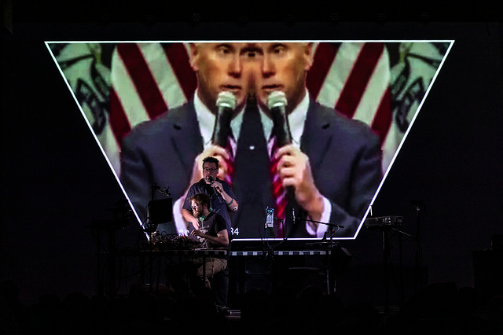Decoder: Ticket That Exploded
By Restless Productions, based on a novel by William H. Burroughs
Created and Directed by Mallory Catlett
Off Off Broadway, Experimental/Adaptation
Played 7.8.19
Pioneer Works, 159 Pioneer Street, Red Hook, Brooklyn
by Emily Cordes on 7.10.19
 G. Lucas Crane and Jim Findlay in Decoder: Ticket That Exploded. Photo by Maria Baranova.
G. Lucas Crane and Jim Findlay in Decoder: Ticket That Exploded. Photo by Maria Baranova.
BOTTOM LINE: A dystopian multimedia immersion, inspired by the work of William H. Burroughs.
Created in 1984 and inspired by writer William H. Burroughs’ Nova trilogy, the West German sci-fi film Decoder holds something of a cult-classic status, depicting the power of mass media to simultaneously control the population and subvert existing systems of dominance. With the advent of social media, and the current administration’s penchant for modifying the “truths” we receive, Burroughs’ premise remains unsettlingly relevant, and worth revisiting in light of our present historical circumstances. In this spirit, Restless Productions’ multimedia piece Decoder: Ticket That Exploded reimagines Burroughs’ texts, using live sound editing, video projections, and spoken word performance to create a mechanized-yet-sentient response to the messages that surround us.
In the manner of Burroughs’s free-associative “cut-up” writing technique, performer Jim Findlay and sound artist G. Lucas Crane eschew conventional plot structure in favor of evocative impressionism, building Decoder’s world through a combination of live sound editing, surreal visuals, and excerpts from Burroughs’ writing. Seated at a mixing board onstage, Crane clothes pre-recorded text in a droning electronic background noise that runs throughout. Paired with Findlay’s live spoken-word performance, the effect is one of voices emerging from, or fighting against, the machine’s constant hum. Sequences in which Findlay, in a face-shielding mask, addresses the audience as alien android “Mr. Martin” extend the theme, as the creature fields questions like a smug politician or presses viewers to question that which they witness. References to tape recorders, the devices Burroughs viewed as tools for civil unrest, abound; though praise of such technology may seem dated, these allusions speak to the inherent power in any item granting the ability to document, reframe, interrupt, or modify the flow of information.
>Projected on a triangular scrim behind the performers, Decoder’s kaleidoscopic visuals speak to Burroughs’ insights on addiction, sexuality, and mind control. The organic, man-made, and technological collide as spliced video clips overlap suggestive computer animation, footage of modern politicians, and images of insects, frogs, and natural landscapes, by turns disturbing, stultifying, and hypnotic. Readings of the source texts’ homoerotic alien encounters, as well as Crane’s disrobed interactions with the screen, speak to our animal nature and the quasi-pornographic capacity of media as a means of connection or dominance. Likewise, repeated allusions to “junk” and addiction highlight the intoxicating lure of power and technology, and mankind’s penchant for self-destruction. The repeated, flickering projections have an indoctrinating quality; consciously or unconsciously, they infiltrate our minds with the same frequency as scrolling news feeds or mass-replicated images. Placed in the audience, we have little choice but to sit back and absorb them as the piece progresses.
Though Decoder’s trajectory is more expressive than narrative, its themes of political subversion and the mixed blessing of technology remain as meaningful to today’s audiences as both the film and Burroughs’ writings were to their respective eras. In light of social media’s recent role in revolutions and acts of terror, and our ongoing need to filter and question the news we encounter, the questions Decoder poses become all the more urgent. The larger issue, the piece implies, is how we respond to the information we are fed: do we accept the reality it presents, reject it entirely, or cut up the book and make our own story from its scraps? In any case, Decoder makes it clear that an internal revolution has already begun—and yes, it will be televised.
(Decoder: Ticket That Exploded played at Pioneer Works, 159 Pioneer Street, Red Hook, Brooklyn, on July 8, 2019. The running time was 60 minutes, no intermission. The performance was Mon 7/8 at 9. Tickets were $10. For more information visit pioneerworks.org.)
Decoder: Ticket That Exploded is by Restless Productions NYC, based on text by William H. Burroughs. Created and Directed by Mallory Catlett. Sound/Video Manipulation by G. Lucas Crane. Interaction Design by Ryan Holsopple. Video Design by Keith Skretch. Associate Video Design by Simon Harding. Dramaturgy by Alex Wermer-Colan.
The cast is G. Lucas Crane and Jim Findlay.

